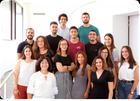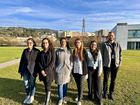People
People involved in the AMRMAR project.

Prof. MD Marco Rinaldo Oggioni
Prof. Marco Rinaldo Oggioni is head of the Microbial Genetics of Infection Research Group at the University of Bologna. He is an expert in bacterial genetics and pathogenesis of infection. MRO has worked as Consultant Microbiologist for 20 years at the University Hospital in Siena (Italy), joined as Professor of Microbial Genetics in 2013 the University of Leicester (UK) and is since 2020 Professor at FaBiT at the University of Bologna (Italy).

Prof. Haitao Ye
Prof. Haitao Ye is a Chair of Materials Engineering at the University of Leicester, where he serves as the Director of Research in the School of Engineering. He specializes in researching thin films and coatings, devices and sensors, and antimicrobial materials for advanced engineering and healthcare applications. His research has been supported by EPSRC, EU-FP7, EU-H2020, Horizon Europe, Innovate UK, Royal Society, and Royal Academy of Engineering. He is a Fellow of Institute of Physics, UK. He serves as the Scientific coordinator for the project and is the work package leader on growth and characterisation of surface functionalised thin film for antibacterial applications.

Teer Coatings
The Technology Development Centre of Teer Coatings Ltd, UK has many expertise in PVD coating researches. Our extensive research portfolio includes mechanical and functional PVD/PECVD coating development as well as coating equipment development for various applications. Teer Coatings Ltd is responsible for numerous UK&EU government-funded research projects in partnership with many academic institutions and industry partners.
Our contribution to the AMRAMR project is: Using the novel Nano-Cluster-Doping technology to develop PVD/PECVD coatings with antimicrobial properties for key applications

Photochemistry Reactivity Group (PRG)
The research of our group (Photochemistry Reactivity Group, PRG, at the University of Valencia), is focused on creating functional nanomaterials, whose performance depends on their capacity to absorb or emit light in the UV-to- NIR region.
In the last decade, we have mainly focused on gold nanoclusters, lead- and lead-free halide perovskite nanomaterials (PK), carbon-based dots, nanoparticles comprising a matrix doped with lanthanide ions (known as upconversion nanoparticles, UCNPs), and lanthanide-dye complexes. Although the features of each of these materials are relevant per se, their combination can result in functional heterostructures (e.g., UCNP-AuNC; PK-UCNP), and core-shell structures (e.g., PK@PK). Moreover, the anchoring of organic dye to the nanoparticles leads to novel nanohybrids (e.g., UCNP-dye; PK-dye) with improved optical properties.
These systems present applications as biosensors, photocatalysts, and/or light-harvesting materials.

Prof. Helena Oliveira
The University of Aveiro team will conduct toxicity evaluations of antibacterial materials using human cell lines. Additionally, the team will perform antibacterial assays using standardized methods.

International Iberian Nanotechnology Laboratory
Our team prepares innovative nanomaterials for different types of applications, such as water and air treatment, smart cities, security and manufacturing. We develop smart, hydrophobic and ecological coatings. We study the structure-property relationships of nanomaterials to designing and engineering materials with desired properties for specific applications. In AMRAMR project we will prepare nanomaterials and functional coatings with antimicrobial properties.

Fudan Group
Dr. Xie Fengxian focuses on research in high-performance opto-eletronic materials and devices. She realized near-100% quantum efficiency in perovskite light materials and developed a thin-film, high-efficiency electroluminescent light-emitting diode. She has also developed various luminescent quantum dot materials for applications in luminescent devices and bio-detection. In addition, she achieved a stable and efficient hybrid perovskite solar cell with an efficiency exceeding 24%.
Dr. Tian’s research interests include the third-generation semiconductor micro-LED devices and their applications in display, optical communication, gravitational wave detection, brain-computer interfaces, and maskless lithography. He independently leads as a Principal Investigator, responsible for laboratory construction, student training, etc.
Prof. Ran Liu received his B.S. degree at Fudan University in 1982, M.S. degree at Shanghai Institute of Technical Physics of Chinese Academy of Sciences in 1985, and Doctor of Natural Science at Max-Planck-Institute for Solid State Research, Germany, in 1990. He subsequently worked as research scientist at the University of Illinois at Urbana-Champaign, the University of Maryland, and the National Institute of Standard and Technology in USA from 1990 to 1996. From 1996 to 2004, he worked at Motorola as a Principle Staff Scientist.
Dr. Yiqiang Zhan obtained his Ph.D. in physics on the topic of "organic electronics" from Fudan University, China in 2005 before moving to ISMN-CNR bologna, Italy as a postdoc. From 2007, he continued his research in Linkoping University, Sweden initially as a postdoc and then as an assistant professor. He joined Fudan University as an associate professor at 2011 and has been promoted to Professor at 2016.
